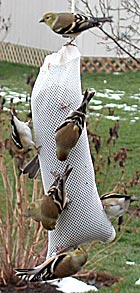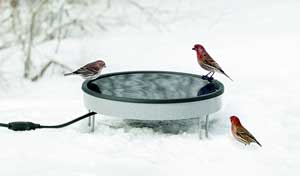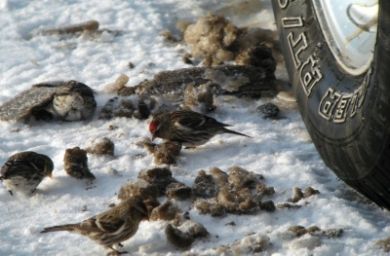Blog - General
Dave’s January Bird Chatter 2013
Dave’s January Bird Chatter
January is a good month for birds to stray into our area looking for a winter home and a source of food. Keep watching for that rare or unusual bird at your feeders that you have not identified or seen before. So far this year the northern Goldfinch population has arrived in good numbers . Their appetite for thistle will continue to increase as they will be with us until the first weeks of May. We are also receiving reports of Pine Siskin, Red-crossbills, and Tufted Titmice in the area. Many people are enjoying Red-breasted Nuthatches at their feeders, a very enjoyable winter addition. More sever snow and ice storms to our north could usher in many other irruptive northern species.
. Their appetite for thistle will continue to increase as they will be with us until the first weeks of May. We are also receiving reports of Pine Siskin, Red-crossbills, and Tufted Titmice in the area. Many people are enjoying Red-breasted Nuthatches at their feeders, a very enjoyable winter addition. More sever snow and ice storms to our north could usher in many other irruptive northern species.
February is the month for the Great Backyard Bird Count and Wild Bird Habitat wants to get everyone thinking and preparing for this for this free, four day bird count. Visit the GBBC website now at www.birdsource.org/gbbc to learn more and make plans to participate. Get the family involved counting bird. Have students count birds in the schoolyard or at a nearby park. Then log your data onto the Great Backyard Bird Count website. It’s a great mid-winter activity for individuals, families, classrooms, scout troops, anyone, to get outside, get some fresh air, enjoy a bit of nature, and be a citizen scientist providing valuable data to biologists. Linda and I usually count birds at coming to our feeders at our home on Friday, the first day of the count. Saturday we count birds at the Pioneers Park Nature Center. Sunday we take a road trip counting birds and log our findings in using the various zip codes where we counted birds. Then we wrap up this annual bird count at our home on Monday. Whether you count the 5 birds you see in your yard or the 75 birds you find walking through your neighborhood or park, every bird you count is important. The information you provide is combined with the Christmas Bird Count and Project Feeder Watch to create a snapshot of the distribution and health of the birds we all have come to love and enjoy. The Great Backyard Bird Count is a project of Cornell University’s Lab of Ornithology and Audubon.

Fresh open water is important to our birds during cold frigid weather. Eating snow or scouting for open water expends valuable energy birds need to survive through the cold winter nights. After all, birds only survive the cold nights on the energy they get from feeding during the day. You can provide open water with a heated bird bath or by adding a bird bath heater to an existing bird bath. These De-Icers are thermostatically controlled and only use as much energy as a 60 watt light bulb. The benefits are you’ll have more birds visiting your backyard.

Birds need grit to help grind and digest the foods they eat. Often they can find gravel and various materials to aid in their digestive process. But when ice and snow pack cover the ground it becomes more difficult to find such products. You can help by offering grit to your birds. It can be placed out separately, or even a little mixed in with food on a platform feeder. An occasional hand full of sand or gravel tossed on the ground will work, or you can purchase granite grit at the Wild Bird Habitat Stores. A little grit can go a long way.
Suet is an excellent winter food source for woodpeckers, nuthatches and other birds of the tree trunk zone. At Wild Bird Habitat we have a variety of suet feeders to meet the needs of these birds. I have even simply rubbed suet on the bark of a tree. The woodpeckers, Carolina Wrens, Brown Creepers, and others enjoy this method of feeding suet especially when the suet feeder itself is overcrowded. Red-bellied woodpeckers will feed on suet, but they seem to prefer reject peanuts or Wild Bird Habitat’s Woodpecker Gourmet Mix. Making both suet and peanuts available to the birds of the tree trunk zone delights a lot of our customers with the birds they attract. Let us know if squirrels are a problem when you offer these products to the birds. Wild Bird Habitat has several solutions.
As you may have read in our December Newsletter, birds do not become reliant on the foods we offer them. They are opportunistic, and as such, take advantage of our generous offerings. It has been proven scientifically, that birds do have a higher survival rate when supplemental foods are made available. In extremely cold weather, birds are basically 36 hours from starvation, surviving only on whatever foods they can consume during the day. Bird feeders are just one of many food sources they have. And as natural food sources become harder to find in mid to late winter, and even into spring, our bird feeders become a source food that enhances their survival.
Brighten up your office, schoolyard, or place of business by installing a bird feeder outside a window. The birds you attract will surely become a topic of conversation, add a little peace to your busy day, and keep you connected with nature. Studies have shown that when people are out in nature or observe nature it lowers one’s stress level. Good birding to everyone.
